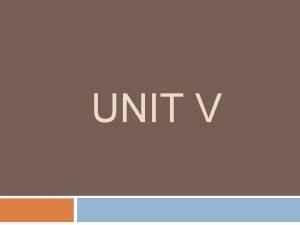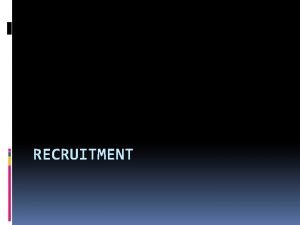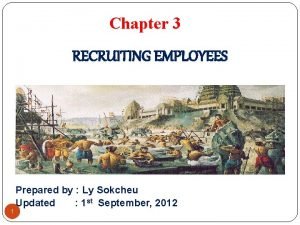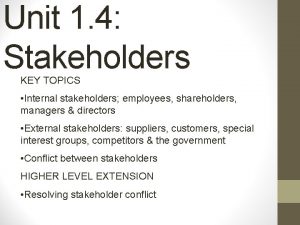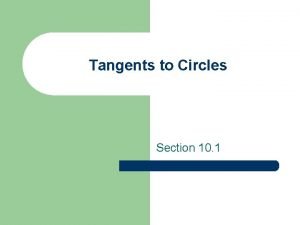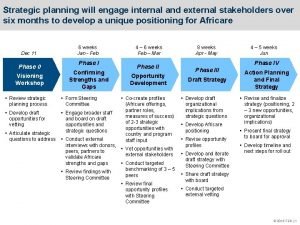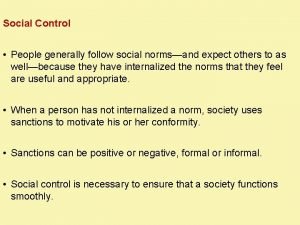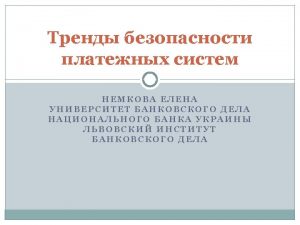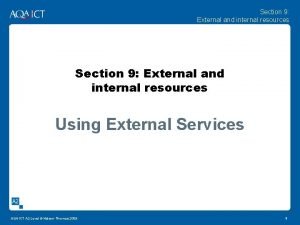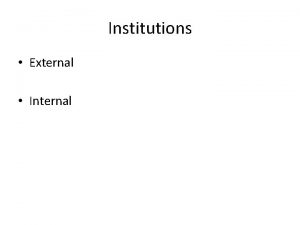UNIT V SOURCES OF FINANCE Internal Sources External






















- Slides: 22

UNIT V

SOURCES OF FINANCE Internal Sources External Sources

Internal Sources Raised from the within the enterprise itself. Owner’s capital – deposits, equity, loans by owner, partners, directors. Personal loans – Provident fund, LI policy, buildings, investments, retention of profits, conversion of some assets

External Sources Raised from external sources. Deposits or borrowings from relatives, friends and others. Borrowings from banks for working capital. Credit from commercial banks. Term loans from financial institutions. Hire purchase or leasing facility from NSIC and SSIC. Seed / Margin money, subsidies from Govt

Internal & External Sources Personal funds or equity capital Loans from relatives and friends Mortgage loans Term loans – shares, debentures, financial institutions, commercial banks, public deposits, retention of profits � Short term, medium term, long term Subsidiaries

Sources of short term finance Commercial banks Public deposits Trade credits Factoring Discounting of bills Bank overdraft Accrued accounts Advances from customers

INSTITUTIONAL FINANCE TO ENTREPRENEURS Commercial banks Other financial institutions � IDBI � IFCI � ICICI � IRBI � LIC � UTI � SFC’s � SIDC � SIDBI � EXIM Bank

Commercial Banks Scheduled comprises: Commercial Banks(SCBs) � The State Bank of India(SBI) and its associated banks(8) � Nationalized banks(19) � Private sector banks(32) � Regional rural banks(196) � Foreign banks(23) The first bank which initiated financial assistance to small scale industries was SBI

Commercial Banks Nationalization in 1969 paved way for commercial banks in initiating finance to SSI. Commercial banks provided assistance for : � Working capital requirements � Term finance Lead Bank Scheme : RBI initiative which focuses on allotting one SCB to one district for intensive development of banking facilities.

Commercial Banks Credit Guarantee Scheme – Started in 1960, Aims at increasing the credit flow to the SSIs and solving problems of sickness in SSI. Introduced to 22 districts initially and expanded all over the country.

IDBI(Industrial Development Bank of India) Established on July 1, 1964 under Act of Parliament as a subsidiary of RBI. In Feb 1976, IDBI was made as an autonomous institution and ownership was passed to Govt of India. IDBI provides assistance to SSI by refinance and bills rediscounting scheme. SIDF(Small Industries Development Fund) – May

IDBI NEFS(National Equity Fund Scheme) – 1988 to provide equity to tiny and small industries not exceeding Rs. 5 lakhs. In order to make coordinating role more effective, Narasimham Committee has suggested that IDBI should give up direct financing role and perform only promotional and refinancing role.

IFCI(Industrial Finance Corporation of Indi Ltd) Govt of India set up IFCI under IFCI Act in july 1948. In july 1993, it was brought under Companies Act 1956. IFCI extends financial assistance through : � Currency loans � Underwriting/Subscriptions to shares / debentures � Guarantees � Equipment procurement � Equipment finance � Equipment leasing � Buyers and suppliers credit

IFCI Financial resources of IFCI has three components : � Share capital � Bonds and debentures � Other borrowings IFCI schemes : � Interest subsidy schemes to women entrepreneurs � Consultancy fee subsidy schemes for providing marketing assistance to SSI � Encourage modernization of tiny, small scale industries � Control pollution of small & medium scale industries

IFCI Flaws of IFCI : �Discriminatory policy towards small and medium scale industries �Delay in sanction of loans �Failure to exercise control over borrowers

ICICI (Industrial Credit Investment Corporation of India Ltd) Setup in Jan 1955 under Companies Act with the objective of developing small and medium scale industries in private sector. Functions : � Assistance – rupee loans, underwriting and subscriptions to shares / debentures, guarantees � Financial services - Deferred credit, leasing credit, installment sale, asset credit and venture credit � Loans from private investment sources

ICICI (Industrial Credit Investment Corporation of India Ltd) Subsidiaries of ICICI: � Merchant banking division – Industrial credit � Asset Management Company – Mutual Fund � ICICI Investors Services Ltd(1994) � ICICI Banking Corporation Ltd(1994) Though ICICI assists all sectors like private, joint, co-operative and public, the major beneficiary is private sector comprising small scale units.

IRBI (Industrial Reconstruction Bank of In Setup in April 1971 under Companies Act to look after the special problem of sick units and provide assistance in speedy reconstruction and rehabilitation. Initially set up as Industrial Reconstruction Corporation of India (IRCI) and converted into IRBI in 1984. IRCI extended assistance to sick units of textiles, engineering, mining and Foundary industries. IRBI diversified activities into consultancy services, merchant banking and equipment leasing.

LIC (Life Insurance Corporation of India) Setup in 1956 as a wholly owned corporation of Govt of India to nationalize insurance business. Offers a variety of insurance policies to extend social security to various segments of society. Provides loans for housing, water supply, rural electrification to benefit individuals and groups. Also provides loans and underwriting / direct subscriptions to shares and debentures of corporate sector.

LIC (Life Insurance Corporation of India) Assistance sanctioned : �New projects – 37. 3% �Expansion / diversification – 31. 2% �Modernization / rehabilitation / balancing equipment – 12. 4%

UTI (Unit Trust of India) Established under Act of Parliament in 1964 Mobilizes savings of small investors and channelizes them into corporate investments. Provides loans and underwriting / direct subscriptions to shares and debentures of corporate sector. During 1994 -95, UTI launched 9 new schemes like Unit plan, Retirement Benefit Plan, Primary Equity Fund, Unit Scheme.

UTI Assistance sanctioned : �New projects – 50% �Expansion / diversification – 12. 6% �Modernization / rehabilitation / balancing equipment – 1. 7% �Loans for working capital – 34. 9%
 Sources of finance
Sources of finance Internal sources of finance
Internal sources of finance Internal sources of finance
Internal sources of finance Advantages of retained earnings
Advantages of retained earnings Sources of finance leaving cert business
Sources of finance leaving cert business Why do businesses need finance
Why do businesses need finance Short term finance sources
Short term finance sources Print sources of information
Print sources of information Water resources importance
Water resources importance External sources of recruitment
External sources of recruitment Sources of recruitment
Sources of recruitment Firms that require funds from external sources
Firms that require funds from external sources Casual callers meaning
Casual callers meaning Disadvantages of internal sources of recruitment
Disadvantages of internal sources of recruitment External-external trips
External-external trips Internal recruitment sources
Internal recruitment sources Tropism
Tropism External and internal users of accounting
External and internal users of accounting Internal and external stakeholders examples
Internal and external stakeholders examples Internal tangent vs external tangent
Internal tangent vs external tangent Internal vs external stakeholders
Internal vs external stakeholders Stimulus respons modellen
Stimulus respons modellen Informal vs formal social control
Informal vs formal social control

